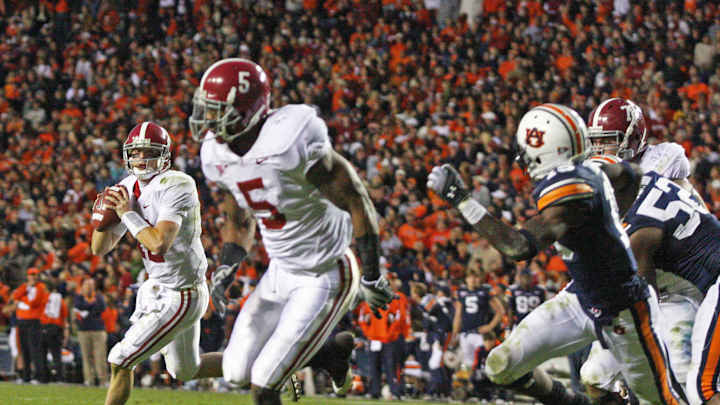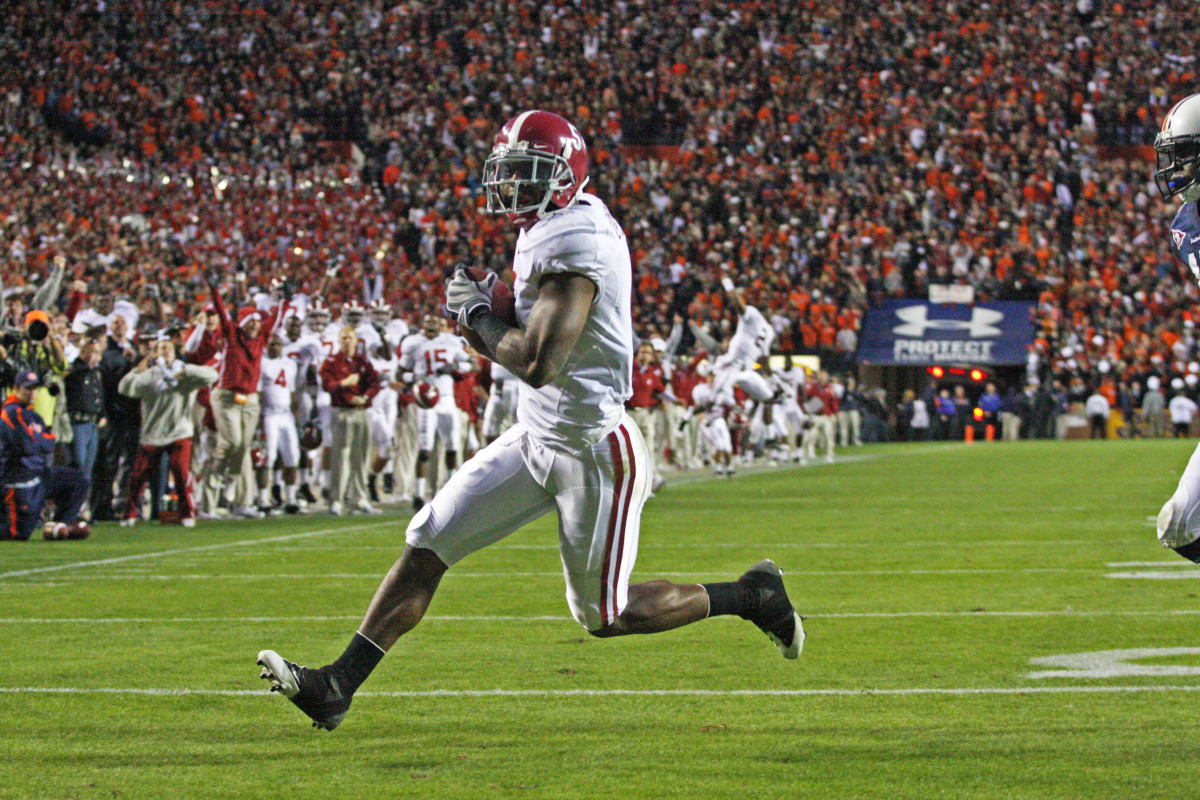On the 10-Year Anniversary, a Detailed Look at 'The Drive'

It was the kind of setting that kids imagine in their backyard, and make players like running back Roy Upchurch a household name in the state of Alabama.
The Crimson Tide was trailing on the road with both an undefeated season and championship run on the line, maybe even for one player the Heisman Trophy. It also wasn’t just any opponent either, but rival Auburn, which had emptied the playbook and called everything from reverses to an onside kick, and even a double-pass while building a two-touchdown lead.
The Tigers had also limited Mark Ingram Jr. to 30 rushing yards on 16 carries, and the running back had also sustained a painful hip-pointer that limited his effectiveness. As All-American left guard Mike Johnson later said it was like Auburn “always seemed to have a guy in the right place at the right time,” and was frequently one step ahead of Alabama.
“Their coaching staff did a great job of game-planning,” Ingram said. “They had eight men up in the box all throughout the day.
“Couldn’t get any room, couldn’t get any space, just couldn't get anything going. They controlled the line of scrimmage so we couldn't get too much of a push. That’s a credit to them.”
Alabama had threatened to take the momentum away for good only to see two drives stall inside the 20, including Ingram missing open wide receiver Julio Jones in the end zone on a halfback-option pass. Yet the two resulting field goals had only brought the Crimson Tide to within a point.
Alabama was a trailing 21-20 as it got the ball at its own 21-yard line with 8:27 left in the game.
In Iron Bowl lore, it’s now known as “The Drive.”
“Just starting out, all we wanted to do was get off to a good start,” quarterback Greg McElroy said. ”I remember vividly, we started off with a run play. We had not been able to do a lot on the ground, or be as consistent as we would like. It was a really up-and-down game.”
Freshman running back Trent Richardson went seven yards off the right edge, followed by the lone incompletion of the 15-play possession, a ball over the middle to junior wide receiver Darius Hanks that was deflected by defensive lineman Jake Ricks.
“Sure enough, up comes a third-and-three,” McElroy continued. “I think everyone in that stadium, including myself, Coach Mac [Jim McElwain], Coach [Nick] Saban, everyone on the sideline, everyone in the stands, assumed and understood that we were going to get the ball to Julio.”

It was a crossing route under the coverage, resulting in an easy 9-yard gain and first down.
“There we go, we’re rolling now,” McElroy said. “Chains are moving. Things are going good. Everything was fantastic.
“The clock’s ticking, and the only thing you’re thinking with a drive like that is no negative plays.”
The next one was, though, because while McElroy executed a play-action for what Alabama called a “blunt pass,” left tackle James Carpenter lost his footing just enough for Antonio Coleman to get around him and hit unaware McElroy from his blindside for a sack.
“First thing that goes through my head is ‘Thank God I didn’t fumble it,’” he said.
Although the fast majority of possessions that involve a sack fizzle out, with second-and-14 Alabama opted to aim for a third-and-manageable situation. McElwain, the offensive coordinator, called Ingram’s number on a screen pass, which he turned into a 9-yard gain.
“So Ingram came in, screen right, took it as far as he possibly could, and I knew at that point Mark wasn’t feeling that great,” McElroy said. “He had gotten hit pretty good earlier in the game. He was trying so hard for his teammates. We appreciated that but you could just tell he didn’t have the gear that we were so used to seeing.”
On third-and-5, the Tide dialed up Jones again on another crossing, or “mesh,” route, only this time the receiver used the game official in the middle of the field as a shield to make sure he was open.
He got six yards for the first down, but was favoring his shoulder when heading off the field. He returned after one play, a 2-yard carry up the middle to midfield by Richardson, and lined up in a different spot on McElroy’s left. Auburn’s answer was to keep cornerback Neiko Thorpe on him in single coverage while ramping up the pressure.
“It was something that we had been working on a lot, it was similar to a curl route, run up about 12 yards and come back to the quarterback,” McElroy said of the 11-yard gain.
With a perfect season on the line against Auburn in 2009, @AlabamaFTBL delivered one of the most memorable touchdown drives in Iron Bowl history. pic.twitter.com/1biNvmLh2L
— CBS Sports College Football 🏈 (@CBSSportsCFB) November 26, 2019
Again, Alabama ran on first down, a pitch to Richardson, who went around the left side to gain four yards before stepping out-of-bounds. It turned into another setup for Jones.
“They just brought more people than we could handle on the left side and Julio had to break off a sight adjustment, and in that particular week for us it was a slant, and he was able to fall forward get us a big (first down),” said McElroy, who further explained: “Our sights changed from week to week. Some weeks it’s one thing, some weeks it’s another, and it’s something that takes a long time in the early part of the week in case they do bring more than you can handle, then you need to make sure you’re on the same page. So Julio did a great job breaking it off and recognizing it.”
With time running down, it became obvious that this would be the make-or-break possession of the game, but with first down at the Auburn 28 the Crimson Tide was still looking at a potential 45-yard field goal. Kicker Leigh Tiffin had made attempts of 31 and 27 yards earlier, but had also missed a 42-yarder and sent a kickoff out-of-bounds.
Alabama went back to Ingram, who after colliding with defensive tackle Nick Fairley for a 1-yard gain, signaled he needed a replacement and limped off the field. His night was over.
The Crimson Tide turned to Richardson, who subsequently had the biggest gain of the drive with a 17-yard screen pass that was aided by blocks by right guard Barrett Jones and Julio Jones.
“It’s just like you draw it up,” McElroy said. “They brought strong pressure on the right side, and their D-line was getting more and more aggressive. Obviously, they could tell that we were getting into position that they didn’t like. They were trying to force us into a negative play. As a result they were bringing a little bit more heat, coming a little bit harder, they were penetrating the gaps a little bit stronger, and Coach Mac did a great play call in calling a screen to Trent – which is similar to what just happened against LSU. Short little screen pass called at the right time, executed perfectly.”

The backbreaking play gave Alabama first-and-goal at the Auburn 10, easily within field-goal range.
“I’m thinking we have a ton of time on the clock and I’m looking up at the board and I’m seeing it ticking, 2:30, 2:20 … the clock is really starting to get low,” McElroy said. “In the huddle, we’re thinking protect the ball, let’s give Leigh Tiffin a chance to win this thing.”
Richardson took a handoff up the middle for 4 yards, and Auburn called time out. He went over the left guard for 3 more, and again Gene Chizik stopped the clock.
The initial play sent in for third down was a run to get the ball to the middle of the field, but before the snap Saban signaled time out and called the whole offense over. He wanted to take a shot at the end zone.
“We’re going to with a play-action pass,” he told McElroy.
“Shoot, that’s awesome,” was the quarterback’s response. “Of course at the same time there’s this sense of nervousness that came over me, gave me a quick shiver, but I tell you what we had worked on that play for weeks. It’s something that we had talked about, greased it up and really cooked it for a long time, and the fact that we were finally about to pull it out, I knew it was going to be a hit for sure.
“So we called Roy over and said that we were about to run the Peter Pass Right X Corner, are you good with that? Bluff the end, get out to the flat and win with leverage.”
“He says: ‘We’re good. No problem.’”
“Roy Upchurch was about as excited as anyone, but if you looked in his eye he was the most laid-back, nonchalant — without sounding negative — very, very relaxed in a very tense situation.”
Alabama inserted massive nose tackle Terrence Cody at fullback, showing a formation it had never thrown out of. Left guard Mike Johnson pulled, Upchurch sold that he was going to make a block until McElroy executed the fake and rolled out. With Upchurch getting a step on Thorpe the play went off without a hitch to complete the 79-yard drive.

After the two-point conversion attempt failed, with Ricks picking off the pass and McElroy tackling the 6-foot-4, 292-pound defensive lineman, Auburn’s last-second desperation heave into the end zone was knocked down by senior safety Justin Woodall. Even though the Tigers had led all but 4:44 of the game, the scoreboard read Alabama 26, Auburn 21.
“That’s what it’s all about,” said McElroy, who completed his last seven passes for 63 yards. “That’s what you play for.”
This story is an excerpt from the book "Decade of Dominance," now available where Crimson Tide books are sold.
